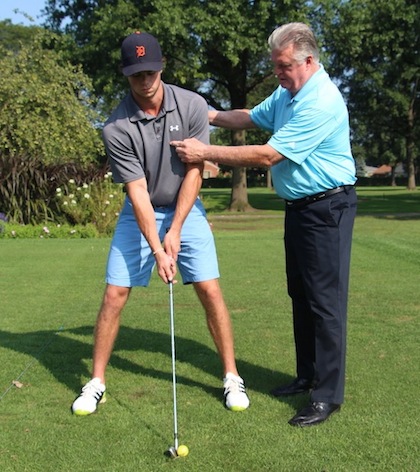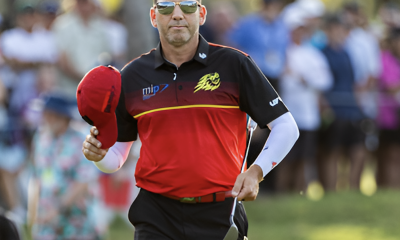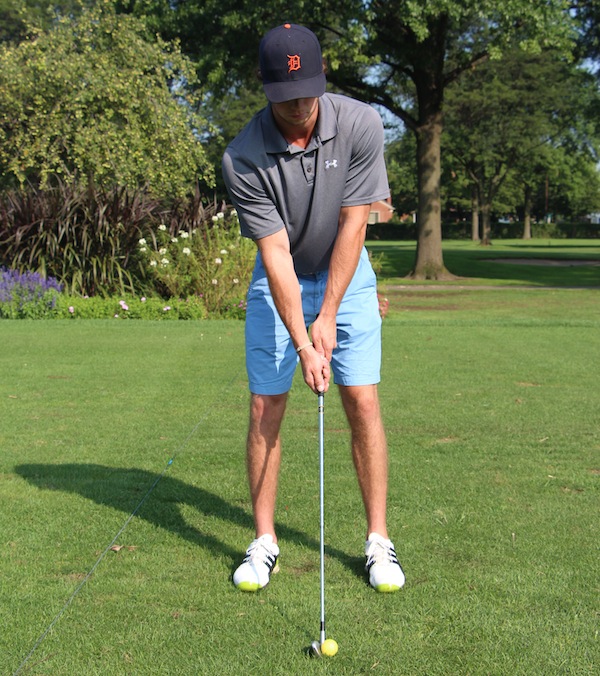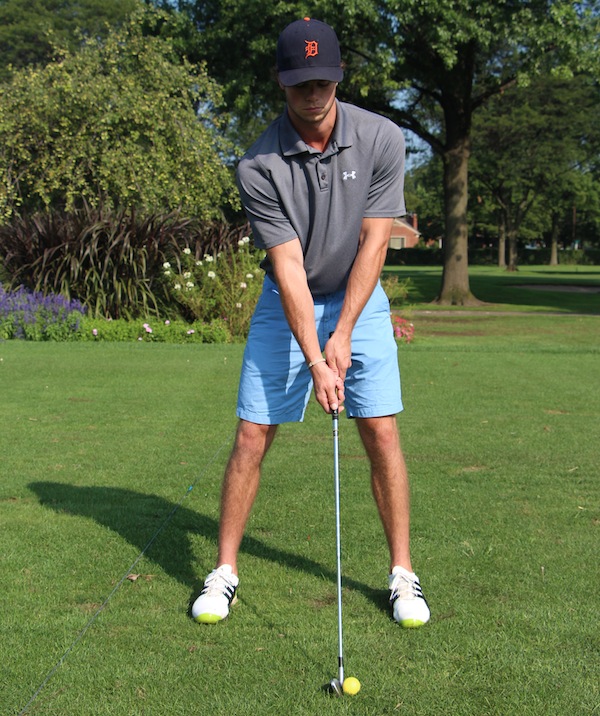Instruction
MacBeth: The Balanced Address Position

I understand that as we are all human and have our own mannerisms, physical make-ups and idiosyncrasies. I am not about to change that, because I cannot. But what I will do is teach you the fundamentals needed for a solid golf swing, why these fundamentals work and the logical reasons behind them.
A sound fundamental golf swing starts with a good grip and a braced, balanced address position. Notice in the picture below how my students feet are relatively close together.
The golf swing, in my opinion, should be an athletic movement of the body simulating a tossing motion. If one starts with his or her feet close together, he or she would inevitably destroy any semblance of balance while executing this tossing motion.
Think about it, would you or a professional tennis player wait for a serve with your feet close together? Would a shortstop wait for a ground ball with his feet that close? How about a basketball player guarding a player? Absolutely not, because they would all be scared to end up off balance!
Let’s make this simple and apply this rule for all clubs on all full shots. When taking your address position, make sure your feet are shoulder width apart from the inside heel measurements.
Notice in the picture below how solid and balanced my student looks with his address position compared to his old address position. In the old position, his feet were narrow, which caused problems with his balance. He also had his chin pointed down, which restricted his shoulder turn.
In the new position, he is now in a “start position” ready to make an athletic move with proper balance. This position can easily be recognized in all the great strikers of the ball.
So why do so many golfers stand with their feet close together? Actually, I believe it stems from the old instruction of swinging or turning “inside a barrel.” I will get into this subject later on why this theory has destroyed many golf swings. For now, take my word for it and start with your feet shoulder width apart from the inside heel measurements for all full trajectory shots.
The second important point I would like the golfer to adhere to in the address position is the proper positioning of the upper portion of the arms to the shoulder areas, creating “connection.” What is connection, you might ask?
Connection is a term created by my mentor, Jimmy Ballard, who has taught more than 300 PGA Tour touring pros such as Hal Sutton, Steve Ballesteros, Jim Colbert, and two-time U.S. Open Champion Curtis Strange to name a few. It is the position that ties in the arms to the body to create the use of centrifugal force for clubhead speed. It maintains the constant radius which, in turn, creates a big arc and enables the golfer to utilize his or her shoulder areas. All three of these factors produce power, distance and accuracy.
Notice in the picture below how I am utilizing my shoulder areas. My arms are extended but connected when I make a tossing motion with the bag. As I complete the motion, notice how my eyes, shoulders and belt buckle are facing the target.
Remember this, tension destroys power and distance! The stiffer your arms are at address, the more tension you create and the more you set yourself up for a “shoulder joint” arm swing. This type of swing destroys power. By swinging the club that way, you are separating the arms from the big muscles of the pecs and lats, thereby swinging with just the arms and not utilizing centrifugal force to create clubhead speed. We want the dog to wag the tail, not the tail wagging the dog!
Look at the example illustrated below. As my student tries to support my golf bag with just his arms (they’re separated from his pecs and lats), it feels heavier to him and creates improper balance by throwing his upper body forward.
Now look at the next two photos and notice how he can support the heavy bag with his big muscles of his shoulder areas maintaining good balance in the legs and up through his upper portion of his body.
Another way of simulating this position is to feel as though you are curling a set of weights. As you hold your arms connected to your body, you can curl the weights relatively easy, but if you were to outstretch your arms away from your pecs and lats, you will notice how difficult it is to support the weight with your shoulder joints.
Just one more example on this subject of address and one that makes sense to all my students. I have seen many talented boxers throw powerful knockout punches. However, I have not seen one boxer throw a knockout punch with his arm extended. Every good fighter throws the punch off his rear leg and from the big muscles of the pectoralis majors and the latissimus dorsi, creating power to knockout his opponent. This is the kind of power we want in the golf swing!
So, the next time you play in a tournament and come to the “longest drive” hole, relax your arms and make sure you are “connected.” The left elbow points to the left hipbone and the right elbow points to the right hipbone with a little pressure applied to the upper arms against the chest. Also, you want your arms extended from your body, but connected to your chest with just the upper portion of the arms. You want the arms to have freedom in the swing while maintaining connection.
Next, make sure your center or spine is straight (simulate a half sitting position with your buttocks sticking out slightly) with your chin up enabling you to free up your shoulders (as seen in the picture of my student above.) Also, with your feet shoulder width apart from the inside heel measurements, apply a little pressure on the inside muscles of your thighs while flexing your knees slightly and gripping the ground with your feet.
Now you are in a position to achieve your maximum potential for distance to win the “longest drive” award!
- LIKE19
- LEGIT0
- WOW8
- LOL0
- IDHT0
- FLOP1
- OB1
- SHANK1
Instruction
The Wedge Guy: The easiest-to-learn golf basic

My golf learning began with this simple fact – if you don’t have a fundamentally sound hold on the golf club, it is practically impossible for your body to execute a fundamentally sound golf swing. I’m still a big believer that the golf swing is much easier to execute if you begin with the proper hold on the club.
As you might imagine, I come into contact with hundreds of golfers of all skill levels. And it is very rare to see a good player with a bad hold on the golf club. There are some exceptions, for sure, but they are very few and very far between, and they typically have beat so many balls with their poor grip that they’ve found a way to work around it.
The reality of biophysics is that the body moves only in certain ways – and the particulars of the way you hold the golf club can totally prevent a sound swing motion that allows the club to release properly through the impact zone. The wonderful thing is that anyone can learn how to put a fundamentally sound hold on the golf club, and you can practice it anywhere your hands are not otherwise engaged, like watching TV or just sitting and relaxing.
Whether you prefer an overlap, interlock or full-finger (not baseball!) grip on the club, the same fundamentals apply. Here are the major grip faults I see most often, in the order of the frequency:
Mis-aligned hands
By this I mean that the palms of the two hands are not parallel to each other. Too many golfers have a weak left hand and strong right, or vice versa. The easiest way to learn how to hold the club with your palms aligned properly is to grip a plain wooden ruler or yardstick. It forces the hands to align properly and shows you how that feels. If you grip and re-grip a yardstick several times, then grip a club, you’ll see that the learning curve is almost immediate.
The position of the grip in the upper/left hand
I also observe many golfers who have the butt of the grip too far into the heel pad of the upper hand (the left hand for right-handed players). It’s amazing how much easier it is to release the club through the ball if even 1/4-1/2″ of the butt is beyond the left heel pad. Try this yourself to see what I mean. Swing the club freely with just your left hand and notice the difference in its release from when you hold it at the end of the grip, versus gripping down even a half inch.
To help you really understand how this works, go to the range and hit shots with your five-iron gripped down a full inch to make the club the same length as your seven-iron. You will probably see an amazing shot shape difference, and likely not see as much distance loss as you would expect.
Too much lower (right) hand on the club
It seems like almost all golfers of 8-10 handicap or higher have the club too far into the palm of the lower hand, because that feels “good” if you are trying to control the path of the clubhead to the ball. But the golf swing is not an effort to hit at the ball – it is a swing of the club. The proper hold on the club has the grip underneath the pad at the base of the fingers. This will likely feel “weak” to you — like you cannot control the club like that. EXACTLY. You should not be trying to control the club with your lower/master hand.
Gripping too tightly
Nearly all golfers hold the club too tightly, which tenses up the forearms and prevents a proper release of the club through impact. In order for the club to move back and through properly, you must feel that the club is controlled by the last three fingers of the upper hand, and the middle two fingers of the lower hand. If you engage your thumbs and forefingers in “holding” the club, the result will almost always be a grip that is too tight. Try this for yourself. Hold the club in your upper hand only, and squeeze firmly with just the last three fingers, with the forefinger and thumb off the club entirely. You have good control, but your forearms are not tense. Then begin to squeeze down with your thumb and forefinger and observe the tensing of the entire forearm. This is the way we are made, so the key to preventing tenseness in the arms is to hold the club very lightly with the “pinchers” — the thumbs and forefingers.
So, those are what I believe are the four fundamentals of a good grip. Anyone can learn them in their home or office very quickly. There is no easier way to improve your ball striking consistency and add distance than giving more attention to the way you hold the golf club.
More from the Wedge Guy
- The Wedge Guy: Golf mastery begins with your wedge game
- The Wedge Guy: Why golf is 20 times harder than brain surgery
- The Wedge Guy: Musings on the golf ball rollback
- LIKE85
- LEGIT13
- WOW5
- LOL1
- IDHT0
- FLOP4
- OB1
- SHANK8
Instruction
Clement: Stop ripping off your swing with this drill!

Not the dreaded headcover under the armpit drill! As if your body is defective and can’t function by itself! Have you seen how incredible the human machine is with all the incredible feats of agility all kinds of athletes are accomplishing? You think your body is so defective (the good Lord is laughing his head off at you) that it needs a headcover tucked under the armpit so you can swing like T-Rex?
- LIKE0
- LEGIT2
- WOW2
- LOL0
- IDHT0
- FLOP0
- OB0
- SHANK2
Instruction
How a towel can fix your golf swing

This is a classic drill that has been used for decades. However, the world of marketed training aids has grown so much during that time that this simple practice has been virtually forgotten. Because why teach people how to play golf using everyday items when you can create and sell a product that reinforces the same thing? Nevertheless, I am here to give you helpful advice without running to the nearest Edwin Watts or adding something to your Amazon cart.
For the “scoring clubs,” having a solid connection between the arms and body during the swing, especially through impact, is paramount to creating long-lasting consistency. And keeping that connection throughout the swing helps rotate the shoulders more to generate more power to help you hit it farther. So, how does this drill work, and what will your game benefit from it? Well, let’s get into it.
Setup
You can use this for basic chip shots up to complete swings. I use this with every club in my bag, up to a 9 or 8-iron. It’s natural to create incrementally more separation between the arms and body as you progress up the set. So doing this with a high iron or a wood is not recommended.
While you set up to hit a ball, simply tuck the towel underneath both armpits. The length of the towel will determine how tight it will be across your chest but don’t make it so loose that it gets in the way of your vision. After both sides are tucked, make some focused swings, keeping both arms firmly connected to the body during the backswing and follow through. (Note: It’s normal to lose connection on your lead arm during your finishing pose.) When you’re ready, put a ball in the way of those swings and get to work.

Get a Better Shoulder Turn
Many of us struggle to have proper shoulder rotation in our golf swing, especially during long layoffs. Making a swing that is all arms and no shoulders is a surefire way to have less control with wedges and less distance with full swings. Notice how I can get in a similar-looking position in both 60° wedge photos. However, one is weak and uncontrollable, while the other is strong and connected. One allows me to use my larger muscles to create my swing, and one doesn’t. The follow-through is another critical point where having a good connection, as well as solid shoulder rotation, is a must. This drill is great for those who tend to have a “chicken wing” form in their lead arm, which happens when it becomes separated from the body through impact.
In full swings, getting your shoulders to rotate in your golf swing is a great way to reinforce proper weight distribution. If your swing is all arms, it’s much harder to get your weight to naturally shift to the inside part of your trail foot in the backswing. Sure, you could make the mistake of “sliding” to get weight on your back foot, but that doesn’t fix the issue. You must turn into your trial leg to generate power. Additionally, look at the difference in separation between my hands and my head in the 8-iron examples. The green picture has more separation and has my hands lower. This will help me lessen my angle of attack and make it easier to hit the inside part of the golf ball, rather than the over-the-top move that the other picture produces.


Stay Better Connected in the Backswing
When you don’t keep everything in your upper body working as one, getting to a good spot at the top of your swing is very hard to do. It would take impeccable timing along with great hand-eye coordination to hit quality shots with any sort of regularity if the arms are working separately from the body.
Notice in the red pictures of both my 60-degree wedge and 8-iron how high my hands are and the fact you can clearly see my shoulder through the gap in my arms. That has happened because the right arm, just above my elbow, has become totally disconnected from my body. That separation causes me to lift my hands as well as lose some of the extension in my left arm. This has been corrected in the green pictures by using this drill to reinforce that connection. It will also make you focus on keeping the lead arm close to your body as well. Because the moment either one loses that relationship, the towel falls.


Conclusion
I have been diligent this year in finding a few drills that target some of the issues that plague my golf game; either by simply forgetting fundamental things or by coming to terms with the faults that have bitten me my whole career. I have found that having a few drills to fall back on to reinforce certain feelings helps me find my game a little easier, and the “towel drill” is most definitely one of them.
- LIKE12
- LEGIT2
- WOW2
- LOL0
- IDHT0
- FLOP2
- OB0
- SHANK8
-

 19th Hole6 days ago
19th Hole6 days agoDave Portnoy places monstrous outright bet for the 2024 Masters
-

 19th Hole2 weeks ago
19th Hole2 weeks agoThings got heated at the Houston Open between Tony Finau and Alejandro Tosti. Here’s why
-

 19th Hole7 days ago
19th Hole7 days agoTiger Woods arrives at 2024 Masters equipped with a putter that may surprise you
-

 19th Hole2 weeks ago
19th Hole2 weeks agoReport: Tiger Woods has ‘eliminated sex’ in preparation for the 2024 Masters
-

 19th Hole1 day ago
19th Hole1 day agoTwo star names reportedly blanked Jon Rahm all week at the Masters
-

 19th Hole2 weeks ago
19th Hole2 weeks agoAddiction, spinal fusion, and scam artists – Everything Anthony Kim revealed in candid interview with David Feherty
-

 19th Hole2 weeks ago
19th Hole2 weeks agoAnthony Kim says doctors told him that he ‘may not have much time left’ ahead of LIV return
-

 19th Hole1 week ago
19th Hole1 week agoBrooks Koepka and Sergio Garcia make significant equipment changes as 2024 Masters looms


























Rob
Sep 26, 2013 at 2:23 pm
I agree with the advice that a wider stance is better for balance and body control however I would not advocate making a stance wider just for the sake of making it wider. Experiment with different widths and find out what works best for you.
Lazza
Sep 26, 2013 at 1:05 pm
I tend to have a fairly narrow stance. Just for interest I tried the wider stance and got some more consistent ball striking. Will be interesting to try it out on the local course in the next few weeks.
Martin
Sep 25, 2013 at 7:49 pm
Seve really was the genius. But Jimmy Ballard didnt do anything to make Seve better, on the contrary the instruction he gave Seve was like cutting of a birds wings and then still expect the poor bird to fly. Seve said in interviews that the instruction he received resulted in that he lost his famous passion, and therefore his game suffered. So to mention that Jimmy Ballard worked with Seve is just stupid. An intelligent trainer would have helped Seve to maintain his passion. Ballards stupid ideas in the eighties of a lot of lateral movement in the swing is also something that was bad for golf. Luckily Leadbetter arrived on the scene…
Nick
Sep 26, 2013 at 2:07 pm
Is there an instructor you’d like to hold out as having never advocated a misguided or poorly stated idea for the golf swing? Leadbetter has gone back on some of his stuff too. Calling Ballards’ ideas “stupid” is an obvious overreach. The idea of a connected swing is still very much a part of mainstream golf instruction today even if certain of Ballards’ ideas have not stood the test of time or proven good for most golfers. Indeed, certain swing concepts or ideas are poison to one mans swing and solid gold to another. Hogan’s ideas in five lessons are often not that great for a slicer. Doesn’t make them wrong or “stupid”.
Dante
Sep 25, 2013 at 2:21 pm
I have a tendency to sway laterally in the back swing and was instructed to narrow my stance to hinder that motion and it has worked very nicely for me. I believe Jay Haas does something similar.
P.S. Steve Ballesteros was an excelletn golfer 😉
Colin Gillbanks
Sep 26, 2013 at 10:00 am
His cousin Seve was even better though!
Good article.